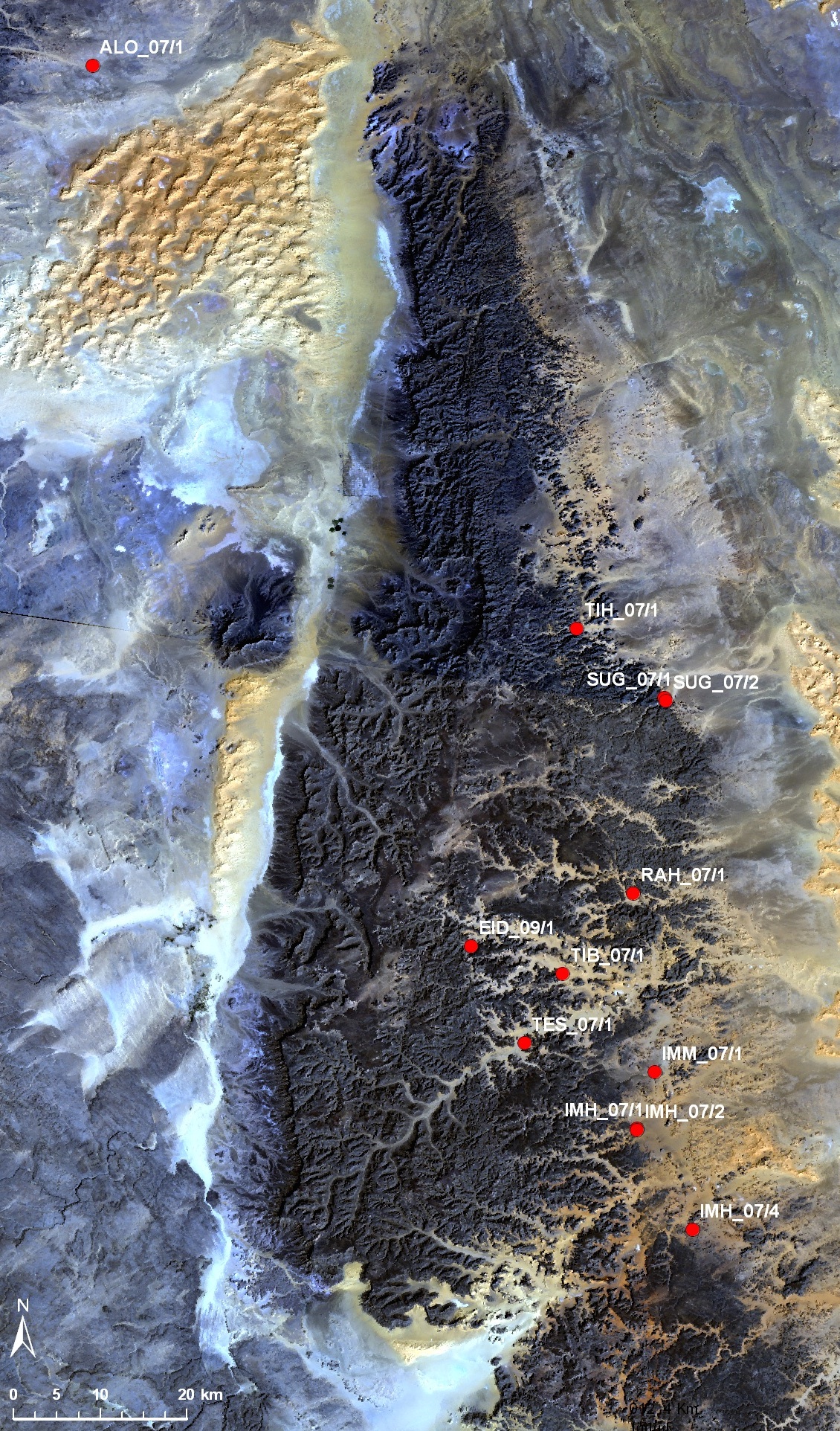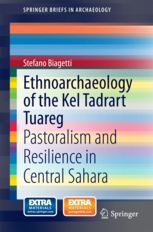PastoralMod
Modelling pastoral adaptation in arid lands
A Tuareg elder adjusts its chech in the middle of cool northern wind, guarding with expert sight his flock coming back to the campsite in the late afternoon. A couple of boys holding curved stick follow, along with a skinny dog. Few straw huts are aligned along the rocky flanks of a wadi, punctuated by shrubs and few Acacia trees. The smell of sweet chai spreads all over the settlement, mixing with the strong odor of sheep and goats. This may be the timeless image of a Tuareg household, dwelling the central Saharan mountains rising between Algeria and Libya. Likewise Beduins roaming on their camels through the Middle East semi-arid rangelands or Fulani herdsmen leading their cattle in the Savannah at the margins of the desert, pastoralists are icons of marginality in the 21st century. They are at the edges of our contemporary sedentary world. No matter where they are, all pastoral societies face similar issues. Threatened by national borders, wars, expanding agriculture, and global market economy, pastoralists may look as outcasts in extinction everywhere. Yet, in the new millennium pastoralists survive and tend to adapt to a variety of situations. Rooted in the past and shaped through time and space, the resilience of these human societies, is, in fact, the key to understand their exceptional adaptation to some of the most inhospitable areas of the planet.
Scientific Rationale
The study of human adaptation to arid environments is currently among the greatest challenges for academia and other institutions. A better knowledge of successful adaptations of pastoralists and other rural communities in marginal lands is required to better understand the human-environment interactions and to improve development plans. In doing this, a major involvement of social sciences and humanities has been recently voiced. On a general level, more has to be learnt about the adaptation of humans to the deserts. In archaeology, for instance, the paradigm "aridity equals to abandonment" was the underlying concept of several reconstructions of cultural trajectories and it has been questioned only in the last years. Yet, the understanding the interactions of societies and environments should start from the adoption of an integrated, interdisciplinary and long-term perspective. Archaeology and anthropology are well suited to unveil the adaptive cycles of human societies, but much has to be done yet. In fact, the Resilience Theory, also known as theory of adaptive change, is based upon the concept of adaptive cycles, made of different phases and developing at different times. Under this framework, we may both avoid simplistic cause-effect assumptions, and develop more refined understanding of the complexity of human-environment interactions, showing unexpected - and sustainable - lifestyles.
Both archaeological and ethnographic landscape of SW Libya are strongly marked by pastoral frequentations (Cremaschi and di Lernia 1998, Dunne et al. 2012, Biagetti et al. 2013, di Lernia 2013, Gallinaro 2013), and contain a set of material evidence, and other locales of interests that highlight the complexity of human-environment interaction in the last eight thousands years. Since the adoption of domesticates, roughly dated to the mid-eight millennium BP, pastoral societies developed in central Sahara, along multiple occupation pulses, which often coincided with periods of higher precipitation. However, Saharan civilizations did not end with the onset of current hyper-arid condition during the Late Holocene. Rather, these new settings gave birth to one of the most ancient African states, the Garamantian kingdom in the Fezzan (ca. 1000BC-AD700), whose existence has only been acknowledged by a wide non-specialist audience in recent years. Later phases (>AD700 onwards) are less known, although not less fascinating: the development of trans-Sahara trade and the existence of a network of centers and inhabited locales deserve much more study to be unveiled. Finally, the present, marked by the occurrence of a variety of Tuareg groups like the Kel Tadrart of the Acacus Mts., that have been the subject of a middle term study by myself (Biagetti, 2014). Due to the exceptional quantity of already available data, this is a favorable place to test such an approach, where a direct-historical perspective may support realistic and long-term interpretive patterns of adaptation to arid climate.
Research objectives
Drawing upon already collected data (Biagetti 2014), this project seeks to improve our understanding of the resilience of the Kel Tadrart Tuareg of the Acacus Mts. (SW Libya) by adopting an ethnoarchaeological approach. The aims of the present project are:
1) To use ethnographic and ethnohistorical data from the Kel Tadrart Tuareg (Libya). To build an agent-based model. An ABM will explore the various options of adaptation to arid lands, including variability, innovation, and resilience. The original ethnoarchaeological dataset will be implemented within a virtual environment based on a Digital Elevation Model (DEM) built using satellite images of the Kel Tadrart landscape. By means of innovative approaches based upon the adoption of SAR (Synthetic Aperture Radar) imagery, main natural resources (e.g. pasture, water) will re-evaluated. Much of the evidence recorded in the course of past fieldwork will be remotely checked and brought together. 'Minor' elements of the archaeological landscape (such as paths, tombs) will be considered as well.
2) To apply the model/simulation approach to investigate past adaptations in SW Libya and surrounding areas in historical times. The ABM will be tested on the evidence of past frequentations in the Tadrart Acacus. The model simulations will be compared to historical frequentation of the study area, with specific reference to the historical occupation pulses, with the aim of developing a set of adaptive cycles within the frame of the resilience theory.
3) To generate a policy-oriented model for the pastoral exploitation of arid and semiarid lands. Being aware of the uniqueness of every pastoral society, the Complexity and Socio-ecological Dynamics Group (CaSEs) at the host institution is the ideal place to further refine and improve the overall research process, in the framework of its wider applicability. Particular attention will be paid to those regions in the Near East, Asia and Southern Europe, where the most successful forms of human adaptation include pastoralism.
References
Biagetti, S. 2014. Ethnoarchaeology of the Kel Tadrart Tuareg. Springer, New York.
Cremaschi, M. and S. di Lernia. 1998. The geoarchaeological survey in the central Tadrart Acacus and surroundings (Libyan Sahara). Environment and cultures. Pages 243-325 in M. Cremaschi and S. di Lernia, editors. Wadi Teshuinat. Palaeoenvironment and Prehistory in South-Western Fezzan (Libyan Sahara). CNR, Milano.
di Lernia, S. 2013. The emergence and spread of herding in Northern Africa: a critical reappraisal. Pages 527-540 in P. J. Mitchell and P. J. Lane, editors. Oxford Handbook of African Archaeology. Oxford University Press, Oxford.
Dunne, J., R. Evershed, M. Salque, L. Cramp, S. Bruni, K. Ryan, S. Biagetti, and S. di Lernia. 2012. First Dairying in 'Green' Saharan Africa in the 5th Millennium BC. Nature 486:390-394.
Gallinaro, M. 2013. Saharan rock art: local dynamics and wider perspectives. Arts 2:350-382.
Published work
Biagetti, S., Ait Kaci, A. and di Lernia, S. (in press) The 'written landscape' of a central Saharan region: digitization and recording of the Tifinagh inscriptions in the Tadrart Acacus Mts (SW Libya). In Collins, C. and Kominko, M. (Eds.), From Dust to Digital. Ten years of the Endangered Archives programme. Open Book Publisher, Cambridge.
Cremaschi M., Zerboni A., Mercuri A.M., Olmi L., Biagetti S., di Lernia S. 2014. Takarkori rock shelter: archive of Holocene climate and environmental changes in the central Sahara. Quaternary Science Reviews 101 (1): 36-60
Biagetti, S. 2013. Designing a pastoral landscape in Saharan massifs - the role of ethnoarchaeology. In Biagetti, S., Lugli, F. and Stoppiello A. A. (Eds.) Ethnoarchaeology: Current Research and Field Methods. Proceedings of the International Conference on Ethnoarchaeology, Rome, 13-14 May, 2010. BAR S2472, Archaeopress, Oxford: 187-192.
Biagetti, S., E. Cancellieri, M. Cremaschi, C. Gauthier, Y. Gauthier, J.-L. Le Quellec, M. Gallinaro, A. Zerboni, and S. Di Lernia. 2013. The Messak Project. Archaeology and heritage management in SW Libya. Journal of African Archaeology 11:55-74.
Biagetti, S., and di Lernia, S. 2013 Holocene deposits of Saharan rock shelters: the case of Takarkori and other sites from the Tadrart Acacus Mts. (SW Libya). African Archaeological Review 30 (3): 305-338
Zerboni A., Biagetti S., Massamba N'Siala I., di Lernia S. 2013. Burning without slashing. Cultural and environmental implications of a traditional charcoal making technology in the central Sahara. Submitted to Journal of Arid Environment 98: 126-131
Biagetti, S. & Chalcraft, J.M. 2012. Imagining aridity: human- environment interactions in the Acacus Mountains, South-West Libya. In: Janowski, M. & Ingold, T. (eds.), Imagining Land- scapes: Past, Present, and Future, Anthropological Studies of Creativity and Perception. Asghate, Farnham, pp. 77-95.
Presentations
Biagetti, S. 2014 Human engagement, indigenous knowledge, and tangible remains: new terrain for ethnoarchaeology? Paper presented at 2014 Chacmool conference, University of Calgary, Canada.
Biagetti, S. 2013. Arid lands, resilience, and variability. The role of ethnoarchaeology in the study of the mechanisms of choice among desert pastoralists. "The Intangible Elements of Culture in the Ethnoarchaeological Research" Rome, CNR, 21st -23rd November 2012.
Biagetti, S. 2012 (invited speaker). Lessons from the present: ethnoarchaeology of contemporary Saharan herders and implications for the archaeological research. "Herders The mobile option", Barcelona (Spain) 31st May 2012. CaSEs (Complexity and Socio-ecological Dynamics Group) Seminars 2012, CSIC, Barcelona, Spain.
 Marie Curie Actions - FP7, Intra-European Felloship 2013
Marie Curie Actions - FP7, Intra-European Felloship 2013


